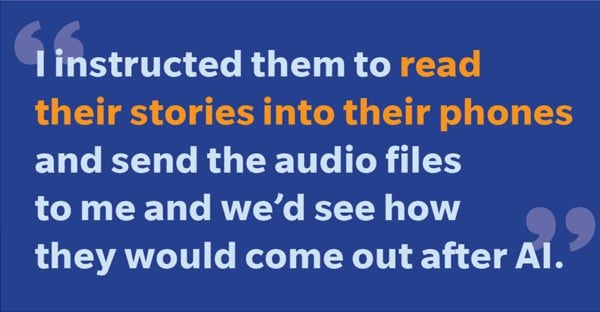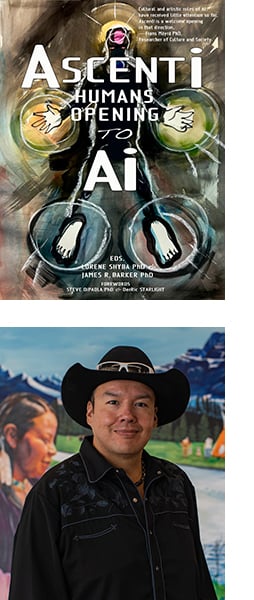AI and Literacy at the Tsuut’ina Nation
I am DerRic Starlight and I am from the Tsuut’ina Nation. My mother is from the Blood Tribe, the Kainai Nation, so I am half Dene and half Blackfoot. I grew up on the reservation of Tsuut’ina, then at age 16, I went into the entertainment business, going first to the Vancouver Film School, then to the Arizona Comedy School and Second City out in Toronto. I also trained in professional wrestling with the Hart family in Calgary. Most recently I trained as a puppeteer with the Jim Henson Company in California, the Sesame Street workshop in New York, and, as well, with Richard Van Camp, to be a book author.
I got involved with the Career and Employment Resource Centre at Tsuut’ina because they have a ‘training for training’ program where if I help trainees with media and book literacy programs, it helps me to pay for my own training in Los Angeles and New York. The programs I run at Tsuut’ina are a five-day digital literacy workshop on how to make a film and website and a five-day writing literacy workshop for writing stories.

I got the idea about running the writing workshop from the Treaty 7 book publishing project we did with Richard Van Camp and the Calgary Public Library, where I came up with the book, Nadudiyiga Suh Sinajuna Morning Star’s Family. I found out I was the first person to have a book published from Tsuut’ina, as an author and also as an illustrator. In the writing workshop, I said to the Tsuut’ina trainees that it would be great to come up with an anthology book, something like what the Blackfoot and Stoney Nations have done. The trainees and the facilitators absolutely loved that idea.
Overall, the trainees’ goals were to find employment, but some people on the Tsuut’ina Nation still have difficulties reading and writing. So, it was a challenge for some of them to write a story for a book. I tried coming up with ideas about what we should write about, like our economic development on the Nation, or what it was like way back, even before we had a casino, but they were bored and wouldn’t even move their pencils to write a sentence.
I knew that with our technologies today, the trainees might be able to make use of their phones to dictate and record stories instead. There was one young woman who was extremely shy and no matter what I tried, I could not break her shell—until I asked her, “What was it like growing up on the reservation, do you have any stories about when you were small?” That really opened her up and she started talking about going shopping with her grandpa. On their way to Walmart, the gas bar was partially on fire and it frightened her. She was very young and she was afraid that when they returned from Walmart the gas bar would be engulfed in flames and it wouldn’t be there anymore. But when they came back from Walmart, she saw firetrucks and the fire had been put out, so she was very happy about that. I said, “That’s great.” She went ahead and recorded the story on her phone.
Going back to my own book Nadudiyiga Suh Sinajuna Morning Star’s Family, it is about my daughter Jessica when she was younger but it is also partially about the relationship between Tsuut’ina and Calgary. When I was at school in Calgary, the city kids wanted to know what was behind that ‘border’ between the city and Tsuut’ina. They would ask me, “What do people do on the reserve? What do you guys do after school? Do you ride horses all day? Do you sleep in tipis?” I would answer that these are all stereotypes, just like cowboys and Indians that they see on TV.
When I explained this to the trainees and asked them to tell stories about their childhood, about their best times, they all went to town with it. I was amazed. The gas bar story that their classmate came up with on her own inspired the rest of the class to tell stories about their childhoods and we ended up using phone recording technology for text recognition. Then I looked into AI grammar programs and put the gas bar story through it and it absolutely worked wonders. It really straightened it out.
Then I went back to the class and said we could try AI with all their stories. I instructed them to read their stories into their phones and send the audio files to me and we’d see how they would come out after AI. They were fascinated that their stories were all fixed up, big time.
As for the illustrations for the book, I was hoping the Indigenous artists at Tsuut’ina would help us with the art but the budget wouldn’t cover their price. So, I thought I would start on them myself, doing the art the way I did for my first book, in a pixel paint program. Then I researched how to use image editing programs and the copyright considerations, and decided on using a program that can take our simple drawings and upgrade them into a beautiful painting. So, the trainees all came up with a drawing of their own and put them through image editing to create final illustrations. When the teachers and facilitators at Tsuut’ina saw the results of the trainees’ stories and illustrations, they were ecstatic.
Now, even the trainees who cannot read or write have a way to tell their stories. We are also working toward getting the stories translated into the Tsuut’ina language. I’d love to build a publishing program, and my goal is to have a hundred books from the Tsuut’ina Dene Nation in the next years.
Here are two examples of stories from trainees at the Career and Employment Resources program.
My Dad’s Gravel Truck
by Derrick Onespot
When I was a young boy, I was always fascinated by my dad’s trucks, especially his gravel truck. I vividly recall the first day I worked with him. When we approached the truck, I remember thinking it was much better than the monster trucks on TV. In my eyes, it was as huge as the ones I saw on TV. The mere thought of riding in it made me ecstatic. This is the most memorable and cherished memory I have of my dad. Someday I hope to create a moment like that with my own future kids.
Stories as Our Guides
by Deneah Big Plume
Our People consider their dreams sacred, and the Creator blesses us with stories we share with pride. We depict these stories on our painted tipis, convey them in the movements of our dances, and express them with the words that flow from our tongues. These stories serve as our guides, leading us on our journey of life. They impart valuable lessons and can provide warmth to our hearts on cold nights. They offer protection with their open arms reminding us that we are not alone. These stories treat us like family. We share our tales with the younger generation who listen to us with eyes full of wonder and carry our words into the future. These stories will not wear or tear, nor will they burn or wash away. These are gifts that cannot be owned, stolen, or sold. As we grow older and our bones lay to rest, we will live on forever through our stories.

DerRic Starlight
DerRic Starlight is a comedian, puppeteer, author, and pro-wrestling promoter. He has appeared in many television productions with APTN (Aboriginal Peoples Television Network) and has won a Gemini Award of Canada as a voice actor. His puppetry has recently been featured in the Fragglerock Television Series.
From the Foreword to Ascenti: Humans Opening to AI, edited by Lorene Shyba, PhD and James R. Parker, PhD. (Durvile & UpRoute). Ascenti publishes on April 1. Ascenti-AI 2024: Symposium on AI and Creative Arts runs April 5–6 at the Calgary Central Library.
Excerpted with permission from Durvile Publications. No part of this excerpt may be reproduced or reprinted without permission in writing from the publisher.
 Contact us via email
Contact us via email

